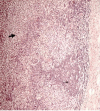Inguinal lymph node metastases from a testicular seminoma: a case report and a review of the literature
- PMID: 21108777
- PMCID: PMC3003676
- DOI: 10.1186/1752-1947-4-378
Inguinal lymph node metastases from a testicular seminoma: a case report and a review of the literature
Abstract
Introduction: We report the case of a true hermaphrodite with testicular seminoma with resulting metastases to the inguinal lymph nodes eight months after radical orchidectomy. This is an unusual presentation of testicular cancer and, to the best of our knowledge, the first report of this kind in the literature.
Case presentation: A 45-year-old Caucasian true hermaphrodite, raised as a male, developed a testicular seminoma. He had undergone a left orchidopexy at the age of 10 for undescended testes. Metastases from testicular tumors to inguinal lymph nodes are a rare occurrence. It has been suggested that previous inguinal or scrotal surgery may alter the pattern of nodal metastasis of testicular cancer. We review the literature to evaluate the incidence of inguinal lymph node involvement in early stage testicular cancer and discuss possible routes of metastases to this unusual site. We also discuss the management of the inguinal lymph nodes in patients with testicular tumors and a previous history of inguinal or scrotal surgery, as this remains controversial.
Conclusion: Inguinal lymph node metastases from testicular cancer are rare. A history of inguinal or scrotal surgery may predispose involvement of the inguinal nodes. During radical inguinal orchidectomy, the surgeon should be careful to minimize the handling of the testis and ensure high ligation of the spermatic cord up to the internal inguinal ring to reduce the risk of inguinal lymph node metastasis.
Figures



References
-
- Cancer Research UK. Testicular cancer incidence and statistics. Cancer Research UK; 2009. http://info.cancerresearchuk.org/cancerstats/types/testis/incidence/
-
- Jamieson JK, Dobson JF. The lymphatics of the testicle. Lancet. 1910;1:493–495. doi: 10.1016/S0140-6736(01)74774-5. - DOI
LinkOut - more resources
Full Text Sources

